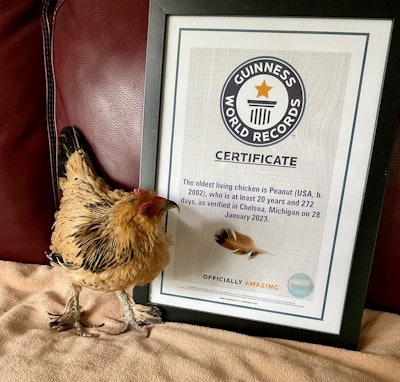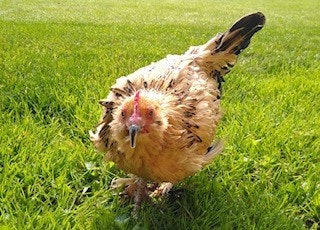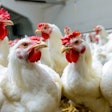
Peanut, a 21-year-old hen from Michigan, was recently named the world’s oldest living chicken by the Guinness Book of World Records.
According to the release, Peanut was 20 years, 304 days old as of March 1, 2023.
“Peanut is a doddering old lady now but she has had quite a life,” said her owner, Marsi Darwin, a retired librarian.
For the first eight years of her life, Peanut worked as a layer and a breeder, producing eggs and offspring. Now a retiree, she spends her days watching TV inside. She also sunbathes and “scratches around” in the dirt outside when it is nice out.
Peanut is even the inspiration for a self-published children’s book, “My Girl Peanut and Me — On Love and Life From the World’s Oldest Chicken.”
The record for the oldest chicken ever is held by Muffy, who died in 2012 at the age of 23 years, 123 days.
 Marsi Darwin
Marsi Darwin
What can we learn from Peanut?
The average commercial layer hen is kept for two to three years. Hens in backyard flock may live a few years longer, although the level of egg production, egg size and shell quality decreases with age.
I somehow suspect that commercial layer barns won’t be adding must-see TV to their operations anytime soon, however there is research that suggests that exposure to videos that simulate a free-range environment can boost layer hen health and welfare.
The researchers studied the effects of virtual reality on a group of 34 hens that were 15 weeks old. This period – when commercial layer hens are typically moved from pullet to egg-laying facilities – is considered a high-risk period of stress.
For five days, video projections played scenes from indoor facilities with access to outdoor scratch areas and unfenced prairies, as well as groups of free-range chickens performing positive behaviors like preening, perching, dust-bathing and nesting.
Hens that received the treatment showed lower indicators of stress and an increased resistance to Avian Pathogenic E. coli (APEC), blood and tissue analysis revealed.



















